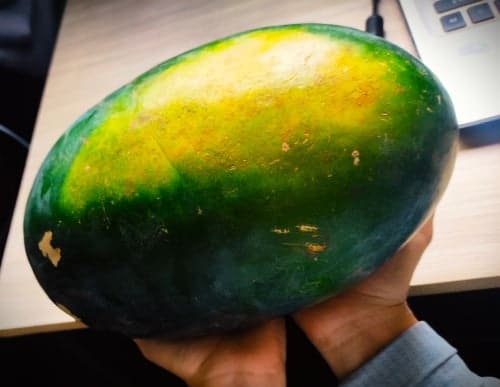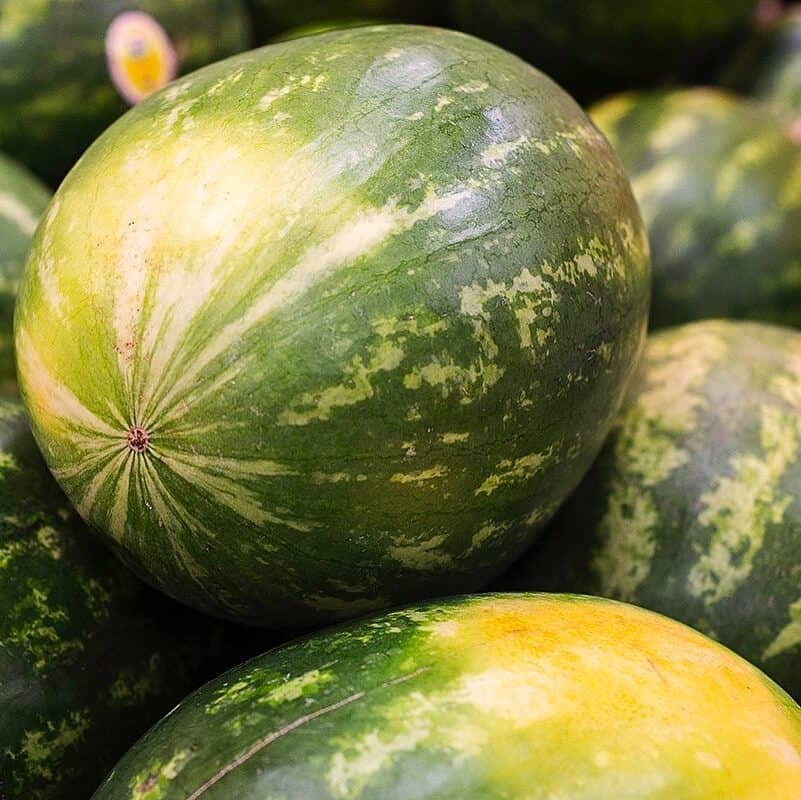Properly ripened Watermelon tastes like a juicy slice of summer with a subtle sweet hint when you know when and how to harvest them.
Many gardeners new to growing Watermelon make rookie mistakes by picking them too soon or too late.
Therefore, to avoid making mistakes, read on to learn signs of ripe Watermelon ready for harvesting.
Table of Contents Show
When does Watermelon Ripe?
After 70 to 80 days of planting Watermelons from seed, they are mature and ready to harvest.
Meanwhile, Watermelon takes almost a month to ripen after its flower blossoms.
Other than these estimated times, you can look for these signs of matured Watermelon to harvest.
1. Fading Watermelon Tendrils
Watermelon vines typically have curly tendrils or pigtails at the connecting node of fruit.
These tendrils or pigtails on the vines start to turn dry and brown with progressing maturity of the Watermelon.
Furthermore, along with the closest tendrils, the leaf may also turn yellow as a sign of ripe fruit.
But if the tendrils are still fleshy green or have not entirely turned brown, Watermelon is not quite ready to harvest.
2. Ground Spot
Another great way to identify the ready-to-harvest Watermelon is by looking at the coloration of a ground spot.
Generally, when the Watermelon is unripe, the color of the belly touching the ground is white.
But with maturing Watermelon, it gradually adds a yellowish tint over time.

When Watermelon ripens, the yellowish tint becomes much more precise and distinguishable.
So, regularly inspect Watermelons and observe the gradual increase in yellow ground spots.
However, do not wait for long, hoping a more intense yellow ground spot as overripe fruit will lose its authentic juicy taste.
3. Thumping Watermelon Sound
You must be familiar with knock-knock jokes, and here you can use that knock to determine the ripeness of Watermelon.
Meanwhile, unripe Watermelon has an intense high-pitched, metallic dull sound.
In contrast to both cases, knocking overripe Watermelon might sound more like a thud.
But inexperienced gardeners like me might face difficulty distinguishing between the sounds.
So, you shall mainly focus on appearances to determine whether they are ready.
4. Squeezing Watermelon
If the Watermelon is properly ripe, they tend to have a soft blossom end, whereas unripe ones have a sturdier, solid blossom end.
Therefore, try squeezing your Watermelon on blossom ends to ensure they are ready to harvest.
But remember, overripe Watermelons tend to have a too-soft outer rind.
5. Size and Weight of Watermelon
Although the shape and size of the Watermelon vary depending on their variety, unripe and ripe ones share some measurable differences.
But unripe Watermelon has a solid green color with white stripes with no signs of a yellowish tint.

Meanwhile, ripe Watermelons are heavier than unripe ones. But too heavy could be a sign of overripening.
Interesting Fact: There is a Guinness world record for the world’s heaviest Watermelon. It weighed 350.5lbs (~159kg) and was grown by Chris Kent of Sevierville, Tennessee.
How to Harvest a Ripe Watermelon?
Unlike Pumpkin fruit, Watermelon does not keep ripening after picking from the plant.
Now, let us jump straight into the best ways of harvesting and storing Watermelon without further delay.
- Sterilize the pruning tools like knives properly before picking off the Watermelon.
- Cut the Watermelon from the vine, leaving almost two or three inches of the stem on the fruit.
- Do not pull the melons from the vine to avoid damage to the plant.

- Store the picked-out fruits at 50 to 60°F, which can be kept for a week or so.
- Maintain temperature above 50°F but less than 90°F to avoid flesh deterioration.
- Store the cut pieces by wrapping them with plastic and storing them in a fridge.
- Do not place Watermelon alongside fruits that release ethylene gas, like apples or bananas, to avoid premature decomposition.
I recommend you dig in sooner to savor the taste of fresh, sweet, and juicy Watermelon without letting it rest in the fridge for more than five days.
If you happen to eat Watermelon seeds, don’t worry! They are harmless, just like Lemon seeds.
Final Thoughts!
Although knowing when to pick ripe Watermelons is a bit of a pickle, it is relatively easy once you figure out the signs.
Headstart Watermelon seeds a few weeks earlier indoors and give them loamy, well-draining soil aided with 1 to 2 inches of water per week.
All The Best!
